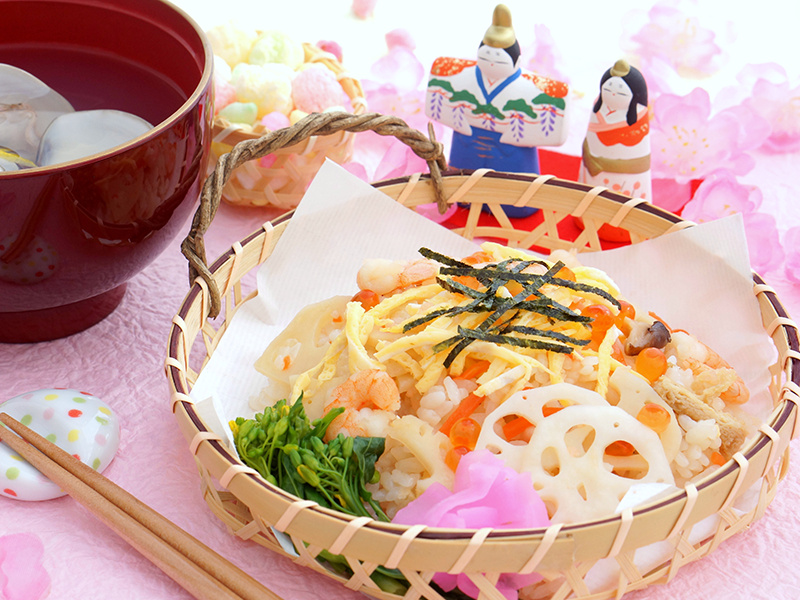TriviaWhat food is eaten on Hinamatsuri?

Here are five auspicious foods for Hinamatsuri.
Chirashi-Zushi
Chirashi-zushi, like Osechi traditional food eaten on the New Year, is made with ingredients that bring good luck. Shrimps are used to wish for a long life until one's back is rounded, lotus root is used to wish for a clear vision of the future because of its holes, beans are used to wish for good health and diligent work, etc. Each ingredient has its own meaning.
Hamaguri Soup
Hamaguri (clams) have long been a symbol of a good marriage, as the shape and pattern of the shells do not match unless they are paired. It is often served as a good luck charm at weddings, and is eaten on the Dolls' Festival in the hope that a girl will be united with the right person.
Hishi Mochi
Hishi-mochi, a rice cake made of three colors (peach, white, and green), is a typical food for Hinamatsuri. The origin of the three colors is that peach (red) is to ward off evil, white is for the "prosperity of descendants" and "longevity" due to the effect of the water chestnuts from which it is made, while green symbolizes "good health” and is eaten to pray for the healthy growth of girls. The layers of peach, white, and green are said to represent the coming of spring, with fresh green budding out of the snow and peach blossoms blooming.
Hina-arare
Hina-arare is one of the most popular sweets for Hinamatsuri. It is said that hina-arare originated when hishi-mochi (rice cakes) were crushed so that they could be eaten outside. In addition to the three colors of hishi-mochi (peach, white, and green), hina-arare also comes in yellow. This is said to represent the seasons of the year. Peach is for spring when flowers bloom, green for summer when the leaves are fresh green, yellow for fall when the leaves change colors, and white for winter when it snows. It is meant to wish for the girl's healthy growth throughout the year.
"Shirozake” White Sake and Amazake
Originally, it was customary to drink "Tokashu" (peach blossom wine) soaked in peach blossoms during the Dolls' Festival. In the Edo period (1603-1867), "Shiro-sake" (sweet white sake) mixed with glutinous rice and rice malt became popular instead of Tokashu. According to a theory, the owner of Toshimaya, a liquor store in Edo, met Hina dolls in a dream and was taught how to make shiro-sake. When he actually sold it, it became popular throughout Edo, and even the Tokugawa shogun came to love drinking it. Thus, the custom of drinking shiro-sake on Hinamatsuri spread throughout the country. Shiro-sake contains about 7% alcohol, so children are not allowed to drink it, and "amazake", which contains no alcohol, is often drunk instead.